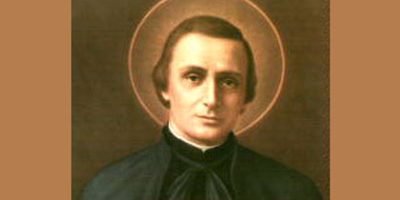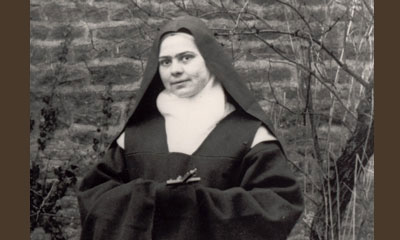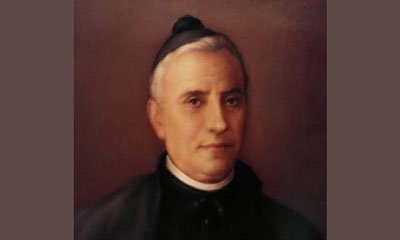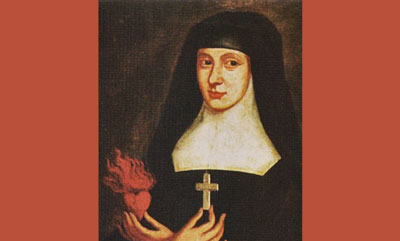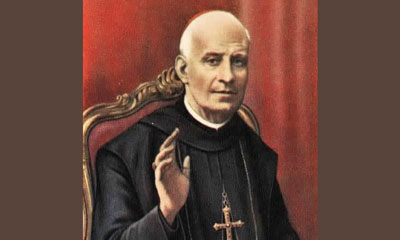June 23, 2017
Saint Peter Chanel
Dear Friends,
“If over the centuries the forces of evil persist in their attacks against the work of the divine Redeemer, God will not fail to answer the anguished prayers of His imperiled sons, arousing souls rich in the gifts of nature and grace, who are for their brothers a comfort and aid,” declared Venerable Pius XII, during the canonization of Peter Chanel on June 12, 1954. This missionary had “the honor of being the first to shed his blood for the faith in Oceania. Scarcely had he consummated the sacrifice of his life on the island of Futuna, which at that time was resistant to grace, than a harvest, rich beyond all expectation, immediately was gathered.”
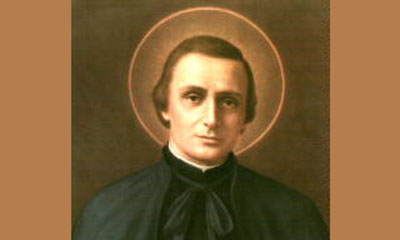 Peter was born on July 12, 1803, in the little village of Cuet, in Montrevel, in what is now the diocese of Belley-Ars (France). He was the fifth of eight children of Claude-François Chanel and Marie-Anne Sibellas. The mother taught her children to love God and the Blessed Virgin, to fear hell and desire heaven. She urged them to avoid sin, which offends God. In 1812, Father Trompier, the parish priest of Cras, suggested to Peter that he join a group of boys who were studying with him for the priesthood. In 1819, Peter continued his studies at the minor seminary in Meximieux, where he felt the first call to leave on overseas missions. He completed his philosophy studies in Belley, before entering the major seminary in Brou, in 1824.
Peter was born on July 12, 1803, in the little village of Cuet, in Montrevel, in what is now the diocese of Belley-Ars (France). He was the fifth of eight children of Claude-François Chanel and Marie-Anne Sibellas. The mother taught her children to love God and the Blessed Virgin, to fear hell and desire heaven. She urged them to avoid sin, which offends God. In 1812, Father Trompier, the parish priest of Cras, suggested to Peter that he join a group of boys who were studying with him for the priesthood. In 1819, Peter continued his studies at the minor seminary in Meximieux, where he felt the first call to leave on overseas missions. He completed his philosophy studies in Belley, before entering the major seminary in Brou, in 1824.
On July 15, 1827, Peter was ordained a priest by Bishop Devie, the first bishop of Belley. In 1822, the diocese of Belley (Ain) had been detached from the diocese of Lyons to which it had belonged. Father Chanel, who had been appointed vicar in Amberieux, immediately won the parishioners’ respect. Penitents flooded his confessional. His kindness and gentleness attracted children and youth in particular. He chose as his motto: “Love Mary and make Her loved.” In his parish, he also introduced the month of Mary devotion, which had not been practiced there until that time. Zealous for the glory of God and the salvation of souls, he did not take care of his health, and eventually suffered the effects thereof. Rather than seeking rest, he thought even more about the overseas missions, and confided in Bishop Devie about this. Instead of sending him on a foreign mission, in 1828 the bishop appointed him the parish priest of Crozet, at the far end of the diocese, close to Geneva. This appointment did not please Peter’s parents, who complained about it to the vicar general. The young priest went to them to console them, and opposed all requests for a change. “If I moved any closer to my parents,” he would confess, “I would move that much further away from the good Lord.” Father Chanel found his new parish in a deplorable state. On Sundays and feast days, the church was nearly empty, with some parishioners even working as on other days. The children, idle and left to their own devices, thought only about playing and learning mischief. Father Chanel went on pilgrimage to Annecy, to the tomb of Saint Francis de Sales who had once visited his parish. He entrusted himself to the Blessed Virgin, and asked religious communities to pray to obtain the conversion of his flock.
By his kindness and gentleness
Conscientiously visiting all families, the poor, and especially the sick, Peter gave children the greatest attention. He was so good at drawing them to himself to instruct them that they never wanted to leave him. After having laid the foundations of a Christian education, Father Chanel attacked the most scandalous disorders of his parish, drawing his inspiration from these words from Holy Scripture: Wisdom reaches mightily from one end of the earth to the other, and she orders all things sweetly (Wisdom 8:1). He also set a strict rule for himself, not to utter any criticism or complaint about his parishioners. He spoke of them only with the sentiments of the best of fathers, and people were understandably convinced that he loved everyone. A priest from Crozet later wrote: “It was most of all by his kindness and gentleness that he reformed the parish from a moral and religious standpoint. His pastoral life was an expression of the Savior’s leniency and charity. He was so good that he had the key to every heart… What good this gentle and active charity performed in the parish! It entirely renewed it.”
As Peter saw it, ignorance was the great enemy of religion. Several times a week, he taught catechism to the children. Every Sunday at Mass and after Vespers, he went up into the pulpit to instruct the parishioners. Most often, he spoke about the importance of eternal salvation, prayer, the justice and mercy of God, devotion to the Blessed Virgin, fear of human respect (particularly the fear of letting others see that one is Christian). Feeling that he was incapable of profoundly renewing his parish on his own, he obtained the favor of a parish mission preached by zealous confreres. The success he had hoped for was not long in coming.
“Come teach us!”
Nevertheless, the longing for foreign missions did not leave his heart. One day he said to some friends: “I see poor idolaters who do not have the happiness of knowing the true God. It seems to me that they are stretching their arms out to me and telling me: ‘Come, come to our assistance; come teach us about your holy religion, which leads to eternal happiness!’” If this call came from God, Peter concluded that he must cultivate a spirit of sacrifice and obedience to answer it. He then felt grow within him an attraction to religious life, in particular, to the Society of Mary, which had originated in 1816 in Lyons, at the foot of Our Lady of Fourviere. In 1831, he met the founder, Father Jean-Claude Colin (1790-1875), who at that time was superior of the minor seminary in Belley. Bishop Devie having given his permission, Peter silently prepared to join the Society of Mary. At the end of August, after vespers he spoke some words of edification to his faithful for the last time, and consecrated his parish to Mary. He then entered the Marists.
Appointed a teacher at the minor seminary in Belley, at the beginning of the following school year he was entrusted with providing spiritual direction for the school. It was above all in the confessional that he gained the esteem and affection of students and professors alike, who took him on as their spiritual guide. He trembled with joy when he saw good taking place. “A retreat was just held,” he wrote in December 1832. “It bore excellent fruit… Having seen our community at the beginning of the school year and seeing them now, is to see night and day, as it were. Our community is changed beyond recognition. Our children are hard-working, obedient, and happy to please others. I assure you that I for my part have wept with joy at this.” At the end of August 1833, he accompanied Father Colin to Rome to submit the constitutions of the Society of Mary to the Holy See. These were approved by Pope Gregory XVI on April 29, 1836. Father Colin would then be elected superior general and the Marist Fathers would pronounce the three religious vows of poverty, chastity, and obedience.
When he returned to Rome, Father Colin, busy running the growing Society, shifted the responsibility for management of the minor seminary onto Father Chanel. Peter, who dreaded this responsibility, wholly devoted himself to it. He came to be nicknamed the “good shepherd.” Available to everyone, he was constantly interrupted, but his always smiling face did not betray any trace of weariness or anxiety. “More than once,” a witness related, “when he was exhausted from the toils of holy ministry, I found him seated in his room, not wishing for any assistance, content with praying in silence, his eyes fixed on the crucifix.”
Begging for prayers
In May 1836, the Holy See entrusted the missions in western Oceania to the Society of Mary. Peter was chosen to leave, and couldn’t have been happier. “We are longing to board the ship that will carry us to Polynesia. It is impossible that we will not run great danger on so long a journey. I am not afraid in the least. I have already made the sacrifice of my life. The only thing I am terrified of is being so unworthy of the apostolic vocation. I am in such great need of the assistance of God and the Blessed Virgin, that I beg everyone for prayers.”
On Christmas Eve of that same year, the apostolic vicar for Western Oceania, Bishop Pompallier, five Marist Fathers, including Peter Chanel, and three catechist Brothers, set out from Le Havre for Chile. From Valparaiso, they sailed to the Gambier Islands. There, thanks to the zeal of the Fathers of the Congregation of the Sacred Hearts of Picpus, the faith was exceptionally well-developed. A great number of Christians attended the Mass that Bishop Pompallier celebrated. During the meeting with the king, the shore was covered with Christians on their knees. The missionaries had trouble making their way through the crowd, because everyone wanted to kiss the hand of the Bishop and the Fathers. Raising his eyes to heaven, Father Chanel said, “O Mary, perform this miracle in the archipelagos that has fallen to us! The glory of Your Divine Son, Your honor and the salvation of souls are at stake.” Having returned to sea, the missionaries landed on Wallis Island on November 1, 1837. Father Pierre Bataillon and a Brother settled there to found the first mission in western Oceania. On November 11, Father Chanel and Brother Marie Nizier founded the second mission, on the island of Futuna. As for Bishop Pompallier, he continued his journey with the other missionaries, all the way to New Zealand.
Father Chanel’s mission consisted of two islands separated by a little channel. The larger, Futuna, stretched out over 46 square kilometers. In 1837, its population was not more than a thousand souls, divided into two kingdoms that were almost constantly at war. The Futunans believed in the existence of gods, all of whom were evil spirits, to whom they attributed sicknesses, scourges, and most of all, death. Their superstitious credulity compelled them to bring offerings to the houses of these gods to appease them. Accustomed to regarding the gods as the sole cause of their evils, they honored them not out of affection but out of fear. They believed in the immortality of the soul, which would, in accordance with one’s works, be punished or rewarded eternally in the afterlife.
Fundamental truths
In the depths of the human conscience are inscribed a number of natural truths regarding the concept of good and evil, the immortality of the soul, death and the retribution that follows it, and God. These concepts, very often mingled with errors, need to be purified by Revelation. The Catechism of the Catholic Church teaches that “man stands in need of being enlightened by God’s revelation, not only about those things that exceed his understanding, but also about those religious and moral truths which of themselves are not beyond the grasp of human reason, so that even in the present condition of the human race, they can be known by all men with ease, with firm certainty and with no admixture of error” (CCC, no. 38), for example the precepts of the Decalogue. The Catechism also explains that “Death puts an end to human life as the time open to either accepting or rejecting the divine grace manifested in Christ. The New Testament speaks of judgment primarily in its aspect of the final encounter with Christ in His second coming, but also repeatedly affirms that each will be rewarded immediately after death in accordance with his works and faith … Each man receives his eternal retribution in his immortal soul at the very moment of his death, in a particular judgment that refers his life to Christ: either entrance into the blessedness of heaven—through a purification or immediately,—or immediate and everlasting damnation” (CCC, nos. 1021 and 1022). In his rule, Saint Benedict exhorts us: “Having our loins girded, therefore, with faith and the performance of good works, let us walk in His paths by the guidance of the Gospel, that we may deserve to see Him who has called us to His kingdom. For if we wish to dwell in the tent of that kingdom, we must run to it by good deeds or we shall never reach it” (Prologue).
Niukili, king of the victorious faction, welcomed the missionaries and allowed them to settle close to his home, in the hope of drawing some temporal benefit from them. Father Chanel began by consecrating his new field of apostolate to Our Lady. Initially, he celebrated the Mass in secret. His first concern was to visit families, and study the language and customs of the country, so that he might soon be able to evangelize them. For Christmas, he invited Niukili and some of those closest to him to attend the midnight Mass in his lowly chapel, decorated and lit as best as possible. The king and the others in attendance were filled with wonder. In the days that followed, people came from different parts of the island to see the Father celebrate the Mass. Although they understood nothing of the liturgy that was unfolding before them, the natives kept profound silence. Among the liturgical objects, the crucifix was the one that struck them more than all the rest. In Father Chanel’s visits across the island, the sight of the crucifix always raised questions. The missionary took advantage of these to proclaim the Gospel. Drawing from Saint Paul, he explained that in handing over His Son for our sins, God shows His plan of benevolent love for us: But God proves his love for us in that while we were still sinners Christ died for us (Rom. 5:8).
“When we meditate on the sufferings and torments of the Redeemer, nothing is better calculated to excite in our souls, sentiments of lively gratitude and love, than to reflect that He endured them voluntarily. Were any one to endure, by compulsion, every species of suffering, for our sake, we should deem his claims to our gratitude very doubtful; but were he to endure death freely, and for our sake only, having had it in his power to avoid it; this indeed is a favor so overwhelming, as to deprive even the most grateful heart, not only of the power of returning due thanks, but even of adequately feeling the extent of the obligation. We may hence form an idea of the transcendent and intense love of Jesus Christ towards us, and of His divine and boundless claims to our gratitude” (Catechism of the Council of Trent, Article IV, 2)
“Our gods would eat us!”
In January 1838, dissentions that had previously existed between the two factions on the island were rekindled and led to a state of war that lasted several weeks. Without delay, Father Chanel went to find the two chiefs and, through an Englishman who remained on the island, endeavored to reconcile them. He did not miss any opportunity to encourage the Futunans to convert to Him Who is Peace, but they remained very attached to their false gods. The few baptisms that he was able to perform were for adults and children who were near death. “Few refuse Baptism when they are close to dying,” he said. The natives observed that the missionary never lost his cheerfulness. They were touched by his charity, always ready to serve them. He never turned them away, in spite of their hardness, ingratitude, coarseness, disrespect, and other defects. All unanimously said that his kindness, gentleness, and modesty were beyond compare. Gradually, Father Chanel won the confidence of some of the youth, and convinced them of the falseness of their superstitious beliefs. However, fear of their gods and the king held them back—“If we became Christians,” they said, “our mean gods would eat us out of anger!” The little success that the missionary’s zeal encountered was the greatest of his hardships. He offered it to his divine Master, for the salvation of the souls that were entrusted to him.
On February 2, 1839, a cyclone destroyed nearly all the homes and plantings on the island. After this disaster, the population was threatened with famine. In August, to Father Chanel’s great sorrow, a fierce battle between the two factions on the island resulted in some forty dead and many wounded. The missionary then did everything he could to bring Niukili to convert, but he sensed the strength of the bonds that held him back. Indeed, to assert his authority, the king had always made his subjects believe that the island’s main deity resided in him. It would cost him greatly to conquer his vanity and admit to his deceptions. The chiefs also were afraid of seeing the disappearance of their authority and the advantage of the gifts offered by the people to please the gods. So Niukili and the elders took a dislike to the Christian religion. To discourage the missionaries, they forbad all contributions of food, and even encouraged islanders to steal the fruit and vegetables they grew.
“Very well!”
With great joy, Father Chanel welcomed a confrere sent to help him, Father Chevron, in May 1840. The horizon seemed to brighten a little—several young people were preparing for Baptism. But in November, Father Chevron had to go to Wallis Island to help Father Bataillon teach his 1,400 catechumens. “I left Father Chanel,” he wrote, “in the midst of persecution. One thought alone consoled me, that I was sacrificing the crown of martyrdom out of obedience, a greater sacrifice for a missionary.” Soon, the king’s own son, Meitala, touched by grace, secretly joined the catechumens. The news of his son’s conversion eventually reached the king. In a transport of rage, Niukili went to his son’s house and warned him, with prayers and threats, to renounce the new religion. In the face of Meitala’s refusal, the king and his counsel decided that Father Chanel must die. Musumusu, one of the chiefs who was fiercely opposed to the Christians, was given the responsibility of teaching the catechumens a lesson, then eliminating the missionaries. Early in the morning of April 28, 1841, a savage horde under his leadership surprised the catechumens in their sleep, roughed them up, and beat them. Once their hatred had been satisfied, the aggressors ran to the missionaries’ house. They found Father Chanel outside the hut and alone, because Brother Nizier was away. Musumusu approached him with treachery, then led him inside, where two of his men were already pillaging the missionaries’ personal effects. Father Chanel was struck violently with a club. Knocked down, he fell back into a seated position, his back pressed to the bamboo wall. Not a complaint or a whimper came from his mouth. Considering martyrdom a grace, he said nothing but the words “Very well,” and he prayed while the savages stole everything they could find. Musumusu, seeing that his men were thinking only of fleeing with their loot, finished off Father Chanel himself, delivering an axe blow to his skull. When the martyr had rendered his soul to God, the sky darkened and a violent explosion was heard. Then the darkness quickly vanished. This wonder terrified the murderers and the inhabitants.
In anticipation of his martyrdom, Father Chanel had warned the catechumens “that religion would not perish, and that after him would come other priests to continue his work.” Shortly after the missionary’s murder, the king, his brother and several others died a death so terrible that everyone considered it a punishment inflicted by God. The catechumens then came out of secrecy, and openly testified to their religion before their fellow countrymen. Meitala stood out among them for his devotion to the faith and his zeal to spread it. A great change took place, such that one year later, in May 1842, Bishop Pompallier, who had come to install new missionaries, found nearly the entire island converted, as if on its own. In fact, through his blood and death, Father Chanel had obtained in great abundance that which his toils and sufferings had not been able to bring about. Musumusu and most of Father Chanel’s murderers would show great remorse and receive Baptism in 1843, confirming once more the truth of these words of Tertullian (theologian, died 220): “The blood of the martyrs is the seed of the Church.”
May the Blessed Virgin Mary, who guided Saint Peter Chanel in his missionary work, help us to work for the salvation of souls, while practicing each day the virtues of kindness and gentleness that the Lord left to us as a legacy.


